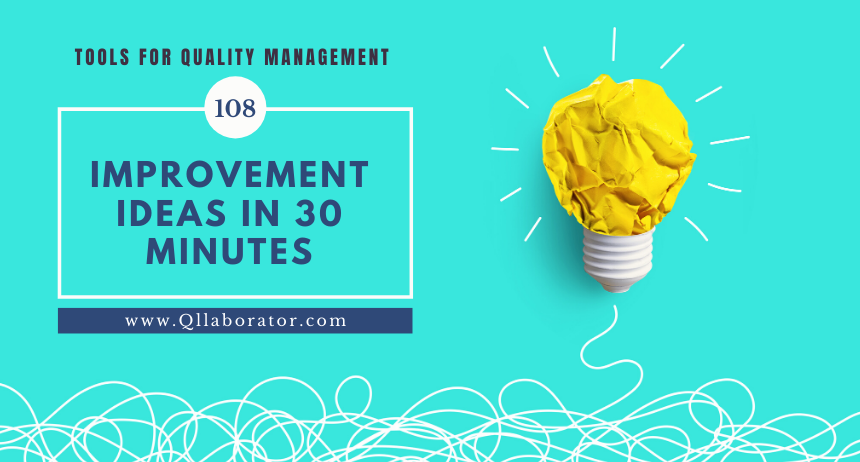
Quality Management Tools Series: 108 Improvement Ideas in 30 minutes – Try 3-5-6 Brainwriting.
Here is an insight from the C-suite: when reviewing with the senior leadership the performance of their quality team, they are often questioning the Q-team tendency to point on gaps and process flaws, but expecting others to fix them. A recurring theme that surfaces up across continents, cultures, business models, and industries. It took me cumulative weeks of conversations with quality leaders from various backgrounds until I finally get it. While it is relatively easy to detect a gap in the system, fixing it is more of a complicated task to pursue. Often, Q-managers are not familiar enough with the correct quality tools and methodologies to deploy. Hence, in their eyes, fixing the gaps they loudly speak on is a kind of mission impossible.
But it pretty clear that what partially worked till now might no longer work in the future. The ever-changing business environment, and the continuous stretching of Design, Engineering and Operational groups, reduce organization tolerances for this kind of behavior. Moreover, it makes the quality team irrelevant, as it perceived as disconnected from what is actually going on. Being the advocator of quality that I am, and out of a sincere belief that proper execution of the quality vision can move the needle (you will be surprised how much), I decided to contribute my part. In this series, the first among who-know-how-many, I will share with you practical and easy-to-execute quality tools, so you too can leap, by moving from finger-pointing to giving-a-hand to the team.
Why 6-3-5 Brainwriting
The tool covered in this article is ‘6-3-5 Brainwriting’. Usually, people use it to generate innovative ideas for new products. However, I will show you how to use it to create an improvement plan toward solving a complex problem.
Let’s face it, no such thing as ‘simple’ problem anymore. Every topic you are drill into covers more dimensions and higher potential for error, with multiple stakeholders from several disciplines and different decision points. Generation a flow of new directions and possibilities to improve products/processes quality is one of the toughest challenges we face, especially when we need to rethink a process and update it to fit the current speed and mode-of-work in your business.
I’m a big fan of brainstorming sessions. In my opinion, this is excellent that brings out my creative side. However, the efforts to lead a successful brainstorming session are significant and required a highly skilled facilitator. Even under these conditions, the yield (a.k.a amount of ideas) is limited to an average of 26 ideas, give or take. Concerning the time, you should book at least half a day, including multiple distractions (you know how it is when the discussion wandering off), and let’s not forget the jokes (none is funny, but you laugh anyway).
In real life (a.k.a your day to day), you have to respond quickly and don’t have the bandwidth to place people from several disciplines in front of a whiteboard, put them in the mood, and start a brainstorming session. However, you can always find time for a 30-60 minutes meeting. Another huge advantage of the 6-3-5 Brainwriting is that by design, it reduces the stress that might be associated with brainstorming, and allow each person to present their ideas, equally.
What is 6-3-5 Brainwriting?
As the name suggests, this method involved 6 brains (or more), each writes down 3 ideas on a worksheet in a 5-minute timebox. When the 5-minutes end, after each participant finished to write 3 ideas, they pass their sheet to the one on their right (or left, if you insist). In the next 5-minutes round, one can choose if to contribute to an idea previously mentioned or start a new one. After 6 consecutive rounds, which are precisely 30 minutes, you will get 108 ideas (according to the developer of this method). I have to say. I did it several times. I personally never touched the magic number of 108 ideas (my best record was 91 ideas).
Now keep in mind, not all the ideas will make it to the final round due to duplications and same-of-the-same. After cleaning up, you’ll get to choose the final candidates, based on success-driven criteria like value and efforts. Commonly, people do it by voting.
It is Up to You Now.
The 6-3-5 Brainwriting methodology allows every quality manager to influence and generate value when facing complex and broad problems, even if they are not familiar with the entire bucket of quality tools. By facilitating a 6-3-5 Brainwriting methodology session, you allow people to create breakthroughs and come with a plan they couldn’t do without you. Once people identify you as a value generator, they will keep coming back and seek your help. Its a chain of reactions that, with time, increase people’s awareness and commitment to quality.
🎁Want to speed up the process? Take this self-assessment and get an insightful analysis of your Quality team performance as well recommended action plan.
❓Any questions? Want to pick my brain? You can ask me whatever you want in this Linkedin group. I will only answer questions posted in the group. Not enough hours in the day to answer all the private messages I get.

